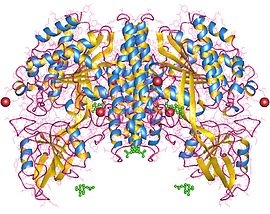Transferrin receptor (TfR) is a carrier protein for transferrin. It is needed for the import of iron into cells and is regulated in response to intracellular iron concentration. It imports iron by internalizing the transferrin-iron complex through receptor-mediated endocytosis.[1] The existence of a receptor for transferrin iron uptake has been recognized since the late 1950s.[2] Earlier two transferrin receptors in humans, transferrin receptor 1 and transferrin receptor 2 had been characterized and until recently cellular iron uptake was believed to occur chiefly via these two well documented transferrin receptors. Both these receptors are transmembrane glycoproteins. TfR1 is a high affinity ubiquitously expressed receptor while expression of TfR2 is restricted to certain cell types and is unaffected by intracellular iron concentrations. TfR2 binds to transferrin with a 25-30 fold lower affinity than TfR1.[3][4] Although TfR1 mediated iron uptake is the major pathway for iron acquisition by most cells and especially developing erythrocytes, several studies have indicated that the uptake mechanism varies depending upon the cell type. It is also reported that Tf uptake exists independent of these TfRs although the mechanisms are not well characterized.[5][6][7][8] The multifunctional glycolytic enzyme glyceraldehyde 3-phosphate dehydrogenase (GAPDH, EC 1.2.1.12) has been shown to utilize post translational modifications to exhibit higher order moonlighting behavior wherein it switches its function as a holo or apo transferrin receptor leading to either iron delivery or iron export respectively.[9][10][11]
| Transferrin receptor 1 | |||||||
|---|---|---|---|---|---|---|---|
 Transferrin receptor 1, dimer, Human | |||||||
| Identifiers | |||||||
| Symbol | TFRC | ||||||
| Alt. symbols | CD71, TFR1 | ||||||
| NCBI gene | 7037 | ||||||
| HGNC | 11763 | ||||||
| OMIM | 190010 | ||||||
| RefSeq | NM_003234 | ||||||
| UniProt | P02786 | ||||||
| Other data | |||||||
| Locus | Chr. 3 q29 | ||||||
| |||||||
| Transferrin receptor 2 | |||||||
|---|---|---|---|---|---|---|---|
| Identifiers | |||||||
| Symbol | TFR2 | ||||||
| Alt. symbols | HFE3, TFRC2 | ||||||
| NCBI gene | 7036 | ||||||
| HGNC | 11762 | ||||||
| OMIM | 604720 | ||||||
| RefSeq | NM_003227 | ||||||
| UniProt | Q9UP52 | ||||||
| Other data | |||||||
| Locus | Chr. 7 q22 | ||||||
| |||||||
Post-transcriptional regulation edit
Low iron concentrations promote increased levels of transferrin receptor, to increase iron intake into the cell. Thus, transferrin receptor maintains cellular iron homeostasis.
TfR production in the cell is regulated according to iron levels by iron-responsive element-binding proteins, IRP1 and IRP2. In the absence of iron, one of these proteins (generally IRP2) binds to the hairpin like structure (IRE) that is in the 3' UTR of the TfR mRNA. Once binding occurs, the mRNA is stabilized and degradation is inhibited.
See also edit
References edit
Further reading edit
- Testa U, Kühn L, Petrini M, Quaranta MT, Pelosi E, Peschle C (July 1991). "Differential regulation of iron regulatory element-binding protein(s) in cell extracts of activated lymphocytes versus monocytes-macrophages". The Journal of Biological Chemistry. 266 (21): 13925–30. doi:10.1016/S0021-9258(18)92790-0. PMID 1856222.
- Daniels TR, Delgado T, Rodriguez JA, Helguera G, Penichet ML (November 2006). "The transferrin receptor part I: Biology and targeting with cytotoxic antibodies for the treatment of cancer". Clinical Immunology. 121 (2): 144–58. doi:10.1016/j.clim.2006.06.010. PMID 16904380.; Figure 3: Cellular uptake of iron through the Tf system via receptor-mediated endocytosis.
- Daniels TR, Delgado T, Helguera G, Penichet ML (November 2006). "The transferrin receptor part II: targeted delivery of therapeutic agents into cancer cells". Clinical Immunology. 121 (2): 159–76. doi:10.1016/j.clim.2006.06.006. PMID 16920030.
External links edit
- Transferrin+receptor at the U.S. National Library of Medicine Medical Subject Headings (MeSH)
- Okam M (2001-01-29). "Iron Transport and Cellular Uptake". Information Center for Sickle Cell and Thalassemic Disorders. Brigham and Women's Hospital and Harvard Medical School. Retrieved 2010-12-19.